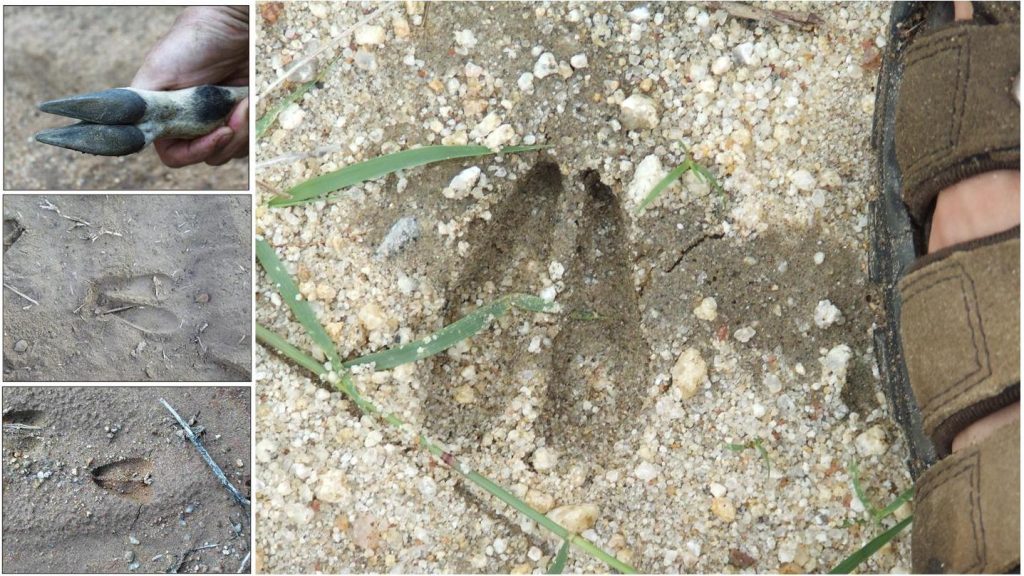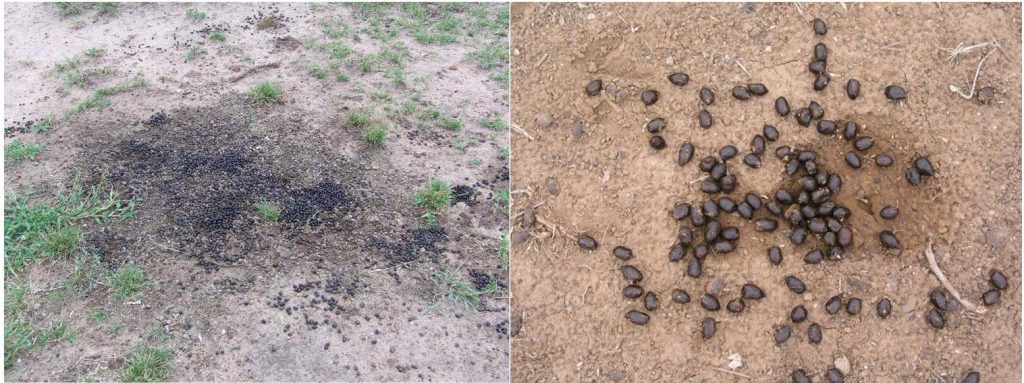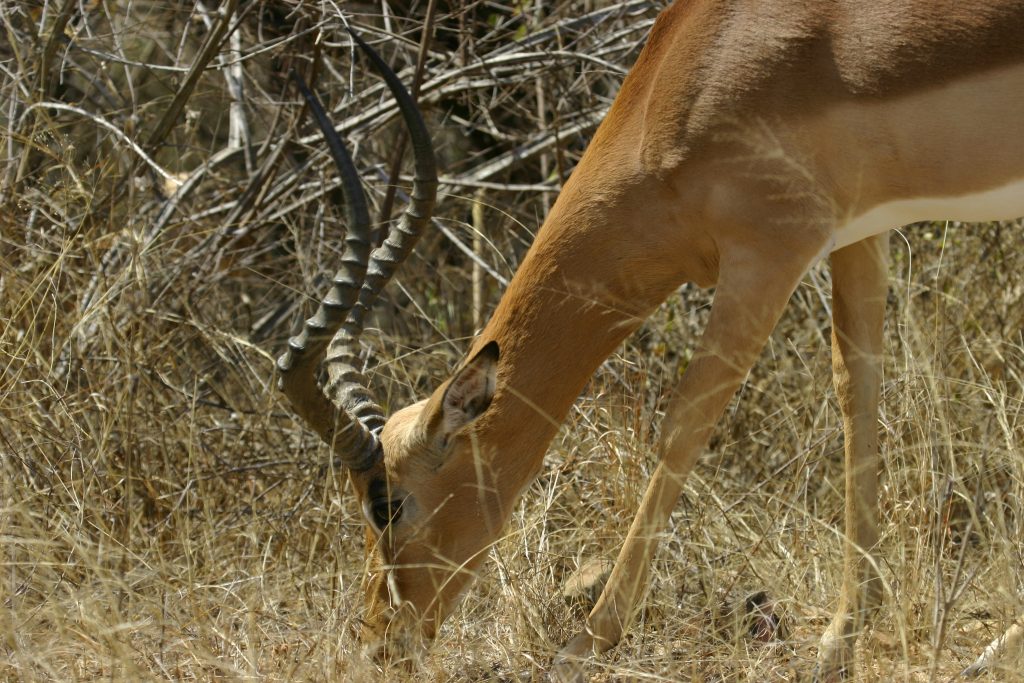Signs to look for
Spoor and scats
Impala spoor is typically cloven hoofed and about 45 – 50mm in length. Front and rear hooves are about the same size and there is no distinct difference between the sexes. See Figure 1.

Spoor is often located on game paths – especially those leading to or from favorite drinking or eating spots. Because they are gregarious animals there are usually a lot of tracks.
Droppings are spherical to cylindrical in shape – pointed at one end and about 12 – 14mm in length. Territorial males deposit dung in latrines, referred to as middens whereas females scat at random. When impala squat to defecate and urinate a difference will show up between males and females in the sign.
In females, the urine will be mixed with the urine, whereas in males, the urine patch will be separated from the scat pellets. See Figures 2-4.



Scat pellets are well-formed and hard during the dry months of the year but may become less well-defined in shape during the early wet season when the grass is green and has a high moisture content.
Feeding signs and other territorial marking – browse lines are sometimes evident in areas with large impala populations. Bushes are sometimes damaged when impala rub their foreheads or thrash vegetation with their horns. See Figure 5.

Sounds – during the rut and to a somewhat lesser extent during the lambing season, impala can be quite vocal. Lambs and females emit a soft bleat. The snorting and guttural vocalizations of rams can help to lead the hunter to his quarry.
Hunting techniques.
Impala are generally vigilant animals, but the habitat they frequent makes the task for the bowhunter a little easier. They are equipped with very acute senses – good sight, hearing, and excellent olfactory ability. Impala are difficult, but by no means impossible to stalk on foot, as long as the hunter is patient, moves at the appropriate time, slowly and quietly, and is patient. Warning signs that impala have been alerted to something are as follows –
- They will stop with what they are busy with.
- They will stand tall and erect with ears pricked and rotated towards the source of disturbance.
- They will stare fixedly at a given spot. They will give an audible warning by forcing air through their nostrils. Foot stamping is common. See Figure 6.

At this point if you are the cause of their interest and assuming you are properly camouflaged stand dead still. After a few minutes, their curiosity might wane or be satisfied and they will settle down again and perhaps give you the opportunity for a shot. If their curiosity turns into suspicion they won’t hang around for long but will trot off to a safer distance and look back to confirm their suspicions.
This is usually well out of bow range. If the suspicion turns into a perceived threat they will scatter at breakneck speed in all directions. Impala will drink water at regular intervals and shooting from a blind or hide is therefore one of the most successful techniques. Impala are however cautious when approaching a waterhole – especially if there are crocodiles and predators in the area. This can often be observed as skittishness.
Their muscle structure becomes visibly more defined when they are tense. Because they are alert when coming to drink, they will respond with quick reactions to any perceived threat whether it be visual, smell, or sound. A tense impala will “string jump” an arrow and it is wise therefore to shoot only when the animal is relaxed and looking away from you.
Take all the necessary precautions for quieting your bow and compensate for the expected string jump, if you are shooting at a tense animal compensate by aiming slightly forward and lower than you would when shooting at a calm animal.
This is for an animal you anticipate will react by moving forward. Impala rest up in the shade during the heat of the day and their alertness declines somewhat. This is a good time to hunt them on foot. They also do not like wind and rain and will bed up in cover to shelter from the elements.
This is also a window of opportunity for the bowhunter. The wind can be used to good advantage and wet ground makes for much quieter stalking. During the rut territorial rams become quite careless, often interpreting the sight or sound of some disturbance, as competition. They sometimes respond by coming to look for the “opposition” which can work in the bowhunters’ favour. Territorial rams will also respond to mimicked grunts and snorts which could bring them within effective bow range.
Shot placement
Impalas are not tough animals. They have a thin skin and a light bone structure which do not present any problems to a sharp, broadhead-tipped arrow. The two best shots, as in most species are a broadside and quartering away presentation. See Figure 6.

For ethical reasons, we avoid frontal or rear-end shots. Shots from above, angling down into the heart/lung area or hitting the spine, are also very effective.
When hit by an arrow the way the animal runs off can give an indication of how hard it has been hit:
- Brain or spinal shot – the animal will drop in its tracks.
- Heart/lung shot – it will bound up into the air then run off at great speed, low to the ground, bounding over obstacles, tail tucked tightly under the rump or “corkscrewing”.
- Gut shot – it will run off in a hunched-up position.
- Leg wound – look for a trailing leg.
- Light wound – will run off in a more upright position than for a heart/lung hit animal. The tail will not be “corkscrewing” but will be in a normal flight position. Will leap high over obstacles.
- Complete miss – the animal will run off at the sound of the string and the arrow landing close by. After the initial flight response, they might stop to look back to try and identify the cause of their fright.
Follow up
Heart/lung shot: Wait at least 30 minutes or until you see the animal go down and expire.
- Liver hit: Wait 1 – 2 hours.
- Gutshot: Wait 8 – 10 hours.
If an impala is not fatally wounded and you follow up too soon, it will become aware of you and make it almost impossible to get a second shot in. When wounded impala will usually look for cover to lie up in.
A wounded impala should, like all wounded animals, be treated with caution but should not be considered dangerous.
Choice of equipment.
Minimum kinetic energy suggested 45 – 50 ft. lbs.
Minimum bow draw weight: 50 lbs. Make sure to silence the bow and equipment.
Arrow type and weight: carbon, A/C/C, aluminium, and wood shafts have all been used with success. If the hunter stays within a 25-yard distance all will work well. Faster arrows – aluminium and carbon – will allow more leeway in distance estimation because of the flatter trajectory. The faster arrow – assuming it is shot from a quiet bow – will also help to offset any “string jumping problems”. The minimum suggested arrow weight with all components is 300 – 350 grains.
Suggested arrow points: because impala are thin-skinned and have a light bone structure almost any broadhead, with good, controllable, flight characteristics will work. Mechanical broadheads have been used with success as well.
Measuring your trophy
SCI method
- Measure the length of each horn along its front curve.
- Measure the circumference of each horn at the base.
- Total all measurements.
Rowland Ward method.
Measure the length of the longest horn on the front curve from the lowest edge of the base to the tip. (Roland Ward records are ranked on the basis of this measurement).
Measure the circumference of the base of the longest horn, at right angles to the axis of the horn. Measure the spread – tip to tip. See Figure 8.

Figure 9 illustrates how to skin an impala for a shoulder mount.

Remember when taking photos of your trophy (Figure 10) to adhere to the ethical rules.


